Production of LED display pilot batch LaMetric
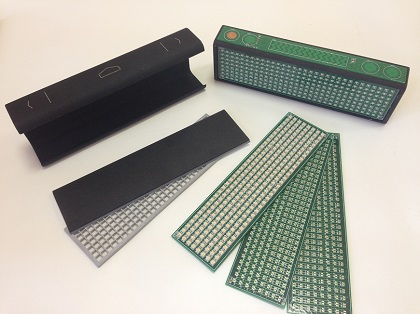
This article will interest those who are working on their own “hardware” project and are faced with the problem of making a pilot batch to test ideas in real conditions. The story is based on our own experience in the startup Smart Atoms when developing our LaMetric product - a smart LED display with the possibility of personalized settings.
In this article I want to pay attention to the production and soldering of boards for the screen, as well as how to improve the quality of soldering without much cost without losing precious time.
Task
It all started with the first prototype, which was implemented using debugging tools in less than two weeks. After checking the idea, we had to make the first small pilot batch, for more thorough testing of all aspects of the product, from design to performance.
Before us were strict requirements for the screen and the size of the case, several of them:
')
a) good color rendition and clearness of display of each pixel;
b) the pixels should be perfectly square;
c) non-standard screen resolution;
d) the screen should be part of the body like the Nike + FuelBand ;
Accordingly, the LED modules existing on the market did not suit us, and the “mockups” on which the first prototype was built simply did not fit into the case.
We had to design and produce individual fees. The difficulties that we met at this stage are soldering. We had to solder boards with very small LEDs, the minimum size of which was 1.5 x 1.5 mm.
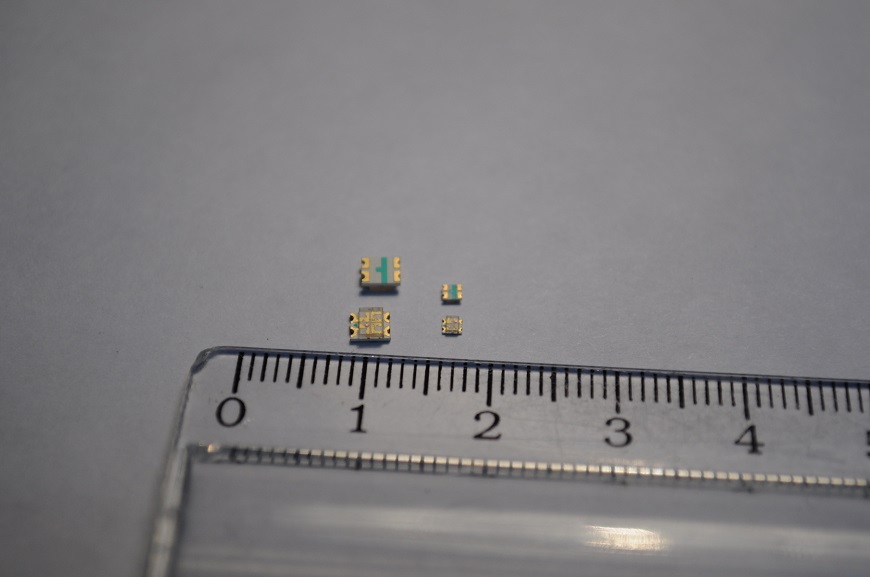
LEDs in a miniature package
The producers we contacted did not want to get involved with small shipments, and if they compromised, the price of the issue was high. Also, the stated deadlines and the fact that the factories were far from our city were not very pleased, and at the early stage of a startup it is very important to have everything at hand.
Decision
The first thing that came to mind was to solder everything by hand. Based on our own experience of soldering surface-mounted device components (surface mounted device), we were well aware that the risk of marriage would be great. Various kinds of defects (“snot”, not even soldered components, etc.) could lead to incorrect screen operation and the pilot batch had a chance to fail.
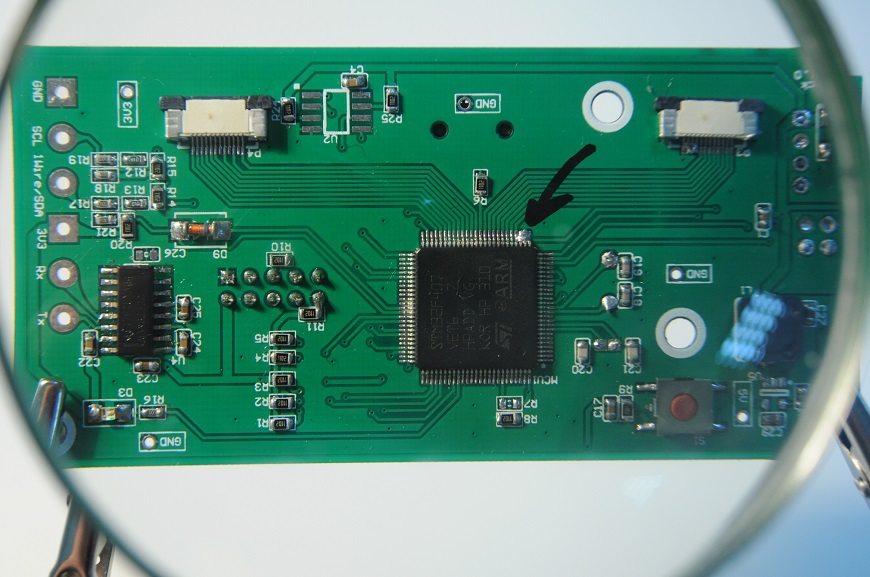
Fee defect “snot”
Therefore, instead of manual soldering, we decided to use surface mounting technology of printed circuit boards (surface mount technology) .
Having designed the boards, we began to look for a manufacturer of a small batch of four-layer boards and a stencil. A stencil is a piece of stainless steel tin, in which holes are cut (apertures) in those places where solder paste should be placed on the contact pads of the components to be mounted. Also, the stencil is stretched on four sides to the frame in order to have less distortion in the plane. Search in the local market did not show any consoling results. The first is the price, the second is the time.
Ordered everything on the Chinese service - Itead Studio . More details about the service can be found in the article . The stencil was designed in such a way that it housed several types of boards. You can safely place any number of boards within the size of the stencil or place the top and bottom layers of the boards, the main thing is to correctly “mirror” everything. After 7 days the order was ready. Delivery took 4 days. Regarding the quality of the issues have arisen. Everything was completed on time.

Stencil and boards
Then it was necessary to apply solder paste to the board. You will need four hands and a trowel. The excess area on the stencil is sealed with tape. Gently position the stencil and press it to the board, then with reinforced movements, apply the soldering paste on the stencil with a spatula. As a result, we get a fee with the optimal dosage of the paste at each contact pad of the SMD component.
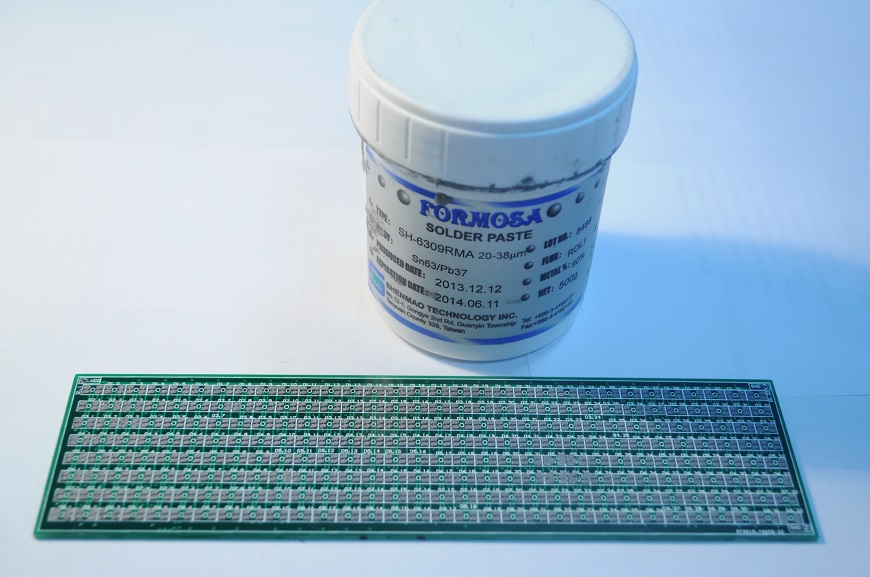
Fee after applying solder paste
The next step is to install the components. Components can be arranged:
- using tweezers;
- with the help of a special “manipulator installation SMD-components”;
- with the help of the “installation machine SMD-components”.
The simplest and most optimal option for us is the first. Here the main perseverance, patience, good lighting, “keen eye” and the presence of a magnifying glass.
We also managed to try out the last two options. The version with the manipulator is not much different from tweezers. The variant with the installation machine is not advisable to use in small batches.
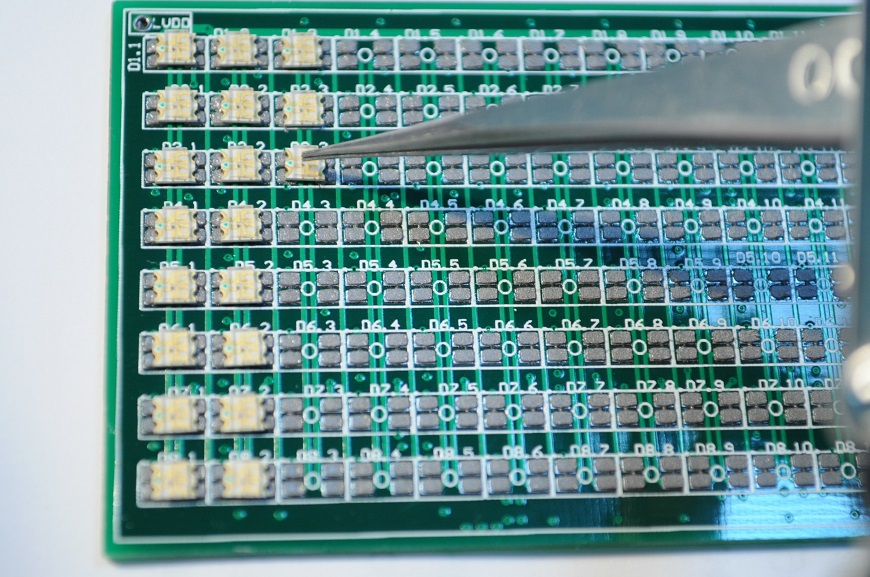
Installing LEDs with tweezers
The finishing procedure is the actual soldering.
Options:
- Using a hot air soldering station.
We set the temperature to about 250-300 degrees. The main thing is not to overheat the SMD-components. Carefully, with circular movements, direct the nozzle of the dryer to the component. (time 10-15 sec., distance 3-7 cm.) If the component is not installed exactly, then self-positioning will occur under the action of surface tension. Our recommendation is to practice first on the test samples, deal with the temperature and force of the air supply, and then proceed to soldering. - Using an SMD soldering furnace.
This method is used in automated production. In our city there is a small factory for the production of LED lamps, where we found the furnace. The furnace looks like a pipe with different temperature regions. In this pipe, a conveyor is installed, along which the boards move with adjustable speed, passing through each temperature region. Unlike the previous version, the soldering process is much easier.
The quality of the soldering is identical in both cases.

Boards with sealed LEDs
Chronology we tried to put in the video:
Soldering process
Conclusion
This process helped us make a test batch promptly and without errors. In just a few days, we tested the product on real users and in real conditions.

Pilot batch of instruments in “combat conditions”
It was important for us to learn all the details of the process in order to sort out all the nuances and not to make mistakes when starting mass production. And we, we strongly recommend that “hard-core” start-ups understand the process and solve all potential problems at the pilot lot stage.
In the next article I plan to talk about 3D printing technologies, which we used for the manufacture of cases.
Source: https://habr.com/ru/post/215519/
All Articles